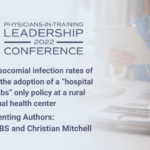Abstract | April 5, 2022
Difference in nosocomial infection rates of inpatients since the adoption of a “hospital laundered scrubs” only policy at a rural regional health center
Learning Objectives
- Help to define the role hospital attire plays in hospital acquired infections.
Background: There has been little research performed at rural tertiary care centers, such as Magnolia Regional Health Center, which describes if a hospital laundered scrub service has any impact on Hospital Acquired Infections (HAI’s). HAI’s we were most interested in were Central Line-Associated Blood Stream Infections (CLABSI’s), Catheter Associated Urinary Tract Infections (CAUTI’s), Surgery Site Infections (SSI’s), Methicillin-Resistant Staph Aureus (MRSA), and Clostridioides difficile Infections (CDI’s).
Methods: A retrospective analysis of confirmed HAI’s over the course of the 12 months prior and 12 months after implementation of a hospital-laundered scrubs initiative, which coincided with the onset of the COVID-19 pandemic in Corinth, Mississippi. Standards set forth by Magnolia Regional Hospital Center identified HAI’s. Using a non-parametric T-test, the data collected was analyzed for significance and relationships.
Results: Between March 2019 and February 2021 there were 117 identified cases of HAI’s. Of the total 117 cases, 21 (17.9%) were CLABSI, 18 (15.4%) were CAUTI, 7 (6.0%) were SSI, 17 (14.5%) were MRSA, and 54 (46.2%) were CDI. Days individuals had Central Lines in place increased post COVID-19 (Mean Days = 422.8, P-value = 0.0003). However, there was no significant difference in HAI’s after the implementation of a hospital laundered scrub service.
Interpretation: The COVID-19 pandemic led to more individuals being hospitalized for longer stays making them more susceptible to getting an HAI during their hospital course. While the data shows no significance for the acquisition of HAI’s after implementation of a hospital laundered scrub service, patients were with Central Lines for a significant longer time frame, suggesting that the hospital was dealing with a sicker patient population. Spread and transmission of HAI’s is multifactorial and may not be able to be distinguished with the study of one preventative measure alone. Based on the research, no argument can be made for or against a hospital laundered scrub system in regard to effectively preventing HAI’s.
Download Full Abstract for References and Resources

